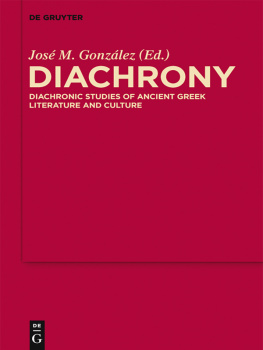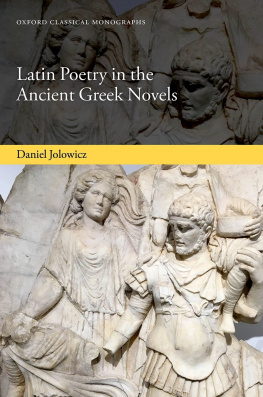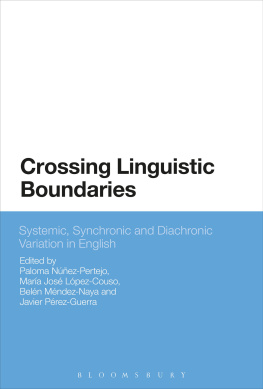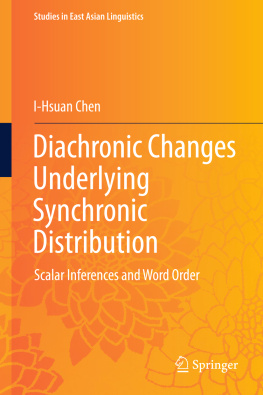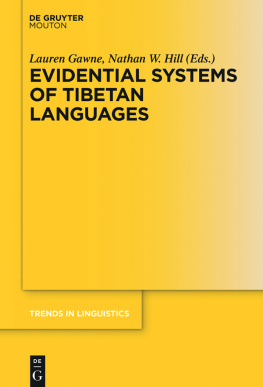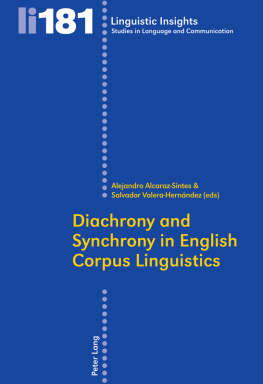Jos M. Gonzlez
1 Introduction
Diachrony in Synchrony
Synchronic and diachronic grammar conflict except where they intersect, the former important for signs (forms, words, syntagmes), the latter solely for sounds (4652). All morphology is syntactic, and grammar is only synchronic; no true historical grammar can exist (5255). Though fundamentally there is but one grammar, equally synchronic and diachronic, the terminology of the two has different values; and synchronic grammar alone istrue since diachrony gives solely a series of events (5961). Synchronic systems are to be explained by themselves, not diachronically, and grammatical categories can be transposed into diachrony only at the cost of their content (67).
One can readily appreciate from this compressed summary how starkly the antinomy had been drawn by Saussure and was felt by the school of linguists who traced to him their genealogy. Saussures own statements were no less definitive:
Therefore a diachronic fact is an event whose cause is in itself; the particular synchronic consequences that may ensue from it are wholly foreign to it. These diachronic facts do not even seek to change the system. No one has wanted to pass from one system of relations to another. ( Cours 121)
Because changes are never made on the system as a whole but on one or another of its elements, they can only be studied apart from it. ( Cours 124)
In language, changes apply only to isolated elements. ( Cours 126)
The chess player intends to effect the move and to exert an action on the system, while language does not premeditate anything; its elements move (or, rather, change) spontaneously and by chance. ( Cours 127)
Despite certain appearances to the contrary, diachronic events are always accidental and particular in character. ( Cours 131)
If the science of language must be ranged under psychology,
If there is a long pedigree for the Swiss schools insistence upon the inherent asystematicity of diachrony and its fundamental incompatibility with the synchronic study of language as a system, so also did its intellectual opponents rise up very soon to contest the claim. The Thses of the Linguistic Circle of Prague, published in the first volume of its Travaux , offered one of the clearest counterstatements. Under Tasks of the synchronic method [and] its relationship to the diachronic method it affirmed:
The concept of language as a functional system must also be considered in the study of past states of language, whether one seeks to reconstruct them or to note their evolution. One should not, like the Genevan School, place impassable barriers between the synchronic and diachronic methods. If in synchronic linguistics one regards the elements of language as a system from the point of view of their functions, one could no longer evaluate the changes suffered by the language without taking into account the system affected by said changes. It would not be logical to suppose that linguistic changes are only destructive breaches that take place randomly and that are heterogeneous from the standpoint of the system. Linguistic changes often aim at the system, its stabilization, its reconstruction, etc. Thus, diachronic study not only does not exclude the notions of system and function but, very much to the contrary, it is incomplete if it does not take these into account . Reciprocally, synchronic description can no longer exclude absolutely the notion of evolution, because even in a sector considered synchronically there is awareness of the state that is on its way out, of the present state, and of the emerging state . Stylistic elements felt as archaisms, then the distinction between productive and unproductive forms, are diachronic facts that cannot be excluded from synchronic linguistics.
Remarkable in this statement is its insistence (i) that diachrony regard systemic relations no less that synchrony, and (ii) that synchronic studies include a certain diachronic awareness (what I call diachrony in synchrony and Jakobson has labeled dynamic synchrony), without which speakers use of their own language cannot be understood. And it is not merely the case that the rationale of parole remains opaque to the outsider who overlooks such diachrony in synchrony, but that speakers themselves resort to this diachronic awareness as they make use of the resources of their language. Resort to diachrony in synchrony belongs to the speakers linguistic competence. Not only are his uses of it systematic (rather than random or fortuitous) but they also embody, and aim at, the systemic structural relations of language.
Roman use that speakers make of it. For Coseriu, linguistic change is not a problem to be explained but an inherent property of language as instrumentally expressive.
This essential quality of language is a fortiori true of poetics and, more generally, of culture as a semiotic system. One often finds in this connection that students of diachronic cultural processes still face today the same challenges and limitations that hampered Saussures treatment. The Swiss linguist explicitly set an espace de temps ( Cours 142) as the proper compass for the systematic study of language, by which he denoted a span that may be as long as ten years, a generation, a century, or even longer. Saussures notion of espace de temps exhibits a shortcoming familiar to anyone who has ever constructed the frequency chart of a continuous variable: by apportioning the data points to the necessarily discrete ranges one artificially erases the points variance within each range. Language never experiences true stasis and a strictly synchronic approach to periodization obscures, if it does not disregard, the diachronic trajectories an espace encompasses. Proper recognition of diachronic variation even within a predominantly synchronic cultural matrix is often categorically prerequisite to the correct interpretation of cultural artifacts.
Another limitation Saussures methodology shares with many contemporary studies of culture regards his privileging for analysis a subset of the data within each period. Critics have often remarked that in practice Saussures espaces de temps coincide with those points of literary history that produced eminent literature. This literature in turn provides the linguists primary or sole analytical focus. The resulting grammars are hardly representative of linguistic communities in all of their variety. They are instead narrow records of high cultural waters, studies of those few exceptional speakers whose output history has bequeathed to us. One cannot claim to know the ancient Greek language of the classical period (even within the limitations imposed by the standard periodization) without some access to the vernacular that none of the highly educated writers extant (especially the poets) are likely to preserve. Fortunately for the scholar whose task is precisely to study the output of these writers, Greek literary history was remarkably traditional in its engagement with a relatively narrow, canonical selection of its past. Therefore, the difficulty here is less the danger of a potentially distorting narrowingwhich typically inheres in the source material and is hermeneutically relevantthan the failure to identify correctly the structure of a works temporal depth, i.e. its specific diachronic texture.
Those who seek to point the way out of Saussures cramping analytic dichotomies must set their focus on historical processes, rather than states, and on the intersubjective character of all communication. Saussures famous analogy of the chess game is only valid if its rules are themselves fixed and it is a particular match alone that the observer wishes to understand. Then, it is true, the match at any stage is adequately described by the identity of the remaining pieces and their positions on the board. The illustration breaks down, however, if the rules themselves are subject to change: one needs then a full account of a sufficient number of successive moves from which to infer and extrapolate valid steps. Knowledge of the internal dynamics with their rate of change would make the progress of a match intelligible. Cultural artifacts and institutions, as the expressive constructs of free interacting human agents, are too complex, and their particular realizations a priori too underdetermined, for the scholar ever to hope that he might unravel their inner logic with predictive force. But this hardly need consign his analysis to despair. He can still broadly consider the evidence for, and the systemic causes of, cultural evolution and how they help to elucidate the situated meaning and significance of these artifacts and institutions.
Next page
